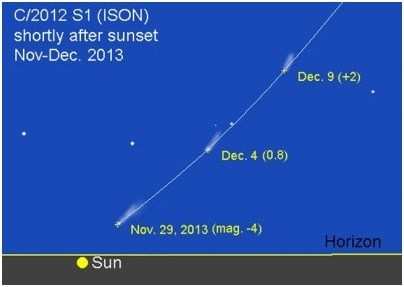Udaipurites likely to view Comet of the Century ‘ISON’ in Dec 2013
In 2013, astronomy enthusiasts in Udaipur would be privileged to witness a great comet through naked eyes. Comet ISON, discovered recently by Russian scientists, will be visible in Udaipur towards the end of 2013.

In 2013, astronomy enthusiasts in Udaipur would be privileged to witness a great comet through naked eyes. Comet ISON, discovered recently by Russian scientists, will be visible in Udaipur towards the end of 2013.
Dr. S. N. A. Jaffrey, Professor of Astronomy & Astrophysics at Department of Physics, Mohanlal Sukhadia University said that the comet will be seen above the western horizon after sunset. It is likely to be visible to the naked eye and could well be brighter than the Moon. However, with its present positioning, it seems that it will be as bright as the moon.
In November-December, we will be able to see Comet ISON. Dr. Jaaffrey, says Comets are often referred to as “dirty snowballs” because they consist of a mixture of ice (both water and frozen gases) and dust.
Astronomers believe that these celestial bodies are made up of material left over during the formation of the Solar System almost five billion years ago.
A comet leads a double life: for much of the time a dull mixture of ice and dust, it transforms itself as it approaches the Sun and turns on a magnificent spectacle.
Most comets reside in a vast sphere shaped reservoir surrounding the Solar System called the ‘Oort Cloud’. The center of this region is a thousand times more distant than Pluto, about 50,000 astronomical units from Earth.
Here, the gravity of passing stars can jolt comets on paths toward the inner Solar System. A second, nearer source of comets is the Kuiper Belt, which is believed to be disk shaped and lies just beyond the orbit of Pluto.
ISON was discovered by Russian astronomers Vitali Nevski and Artyom Novichonok using the International Scientific Optical Network telescope. Astronomers believe that the comet may be brighter than any comet spotted in the last century, visible even in broad daylight, and this may end up being its one and only trip to the solar system, as its trajectory may see it plunge into the sun towards a fiery death.
Comet ISON can be seen with absolute brightness, utmost clarity and may display a colourful cometary tail. It is currently moving inwards from beyond Jupiter, and as it approaches the Earth, the ‘dirty snowball’ could produce a dazzling display. It is on a ‘parabolic’ orbit, which means it probably originated from the outskirts of the solar system, perhaps from the Oort cloud.
This comet can be regarded as the greatest comet of the millennium. The magnitude of this comet will be around -16; none of the comets in history have had such a bright value.
If predictions hold true then Comet ISON will certainly be one of the greatest comets in human history, far outshining the unforgettable Comet Hale- Bopp of 1997 and very likely to outdo the long-awaited Comet Pan-STARRS (C/2011 L4). It is expected to reach binocular visibility by late summer 2013 and a naked eye object in early November of that year.
Northern hemisphere observers are highly favored following its peak brightness in late November it will remain visible without optical aid until mid-January 2014. However, comet brightness predictions sometimes exceed their performance.
Dr. Jaffrey says that IUCAA Resource Centre, Udaipur is going to organize a workshop on appearance of comet ISON in month of December, 2013. All sky watchers and interested students may contact IUCAA Resources Centre, Udaipur for further details.
To join us on Facebook Click Here and Subscribe to UdaipurTimes Broadcast channels on GoogleNews | Telegram | Signal


